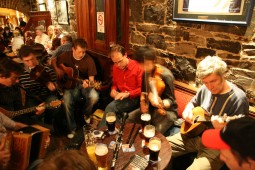
The History of Traditional Irish Music
The Gaels first composed traditional Irish music in Ireland over 2000 years ago, and it has become popular worldwide since then. The first form of harp originated in Ancient Egypt 2500 years ago. In the tenth century, it became a crucial component of Irish music. During the seventeenth century the Chieftains employed professional harpists to perform for them. However when the Chieftains had to leave their home due to the foreign invaders, the recently unemployed harpists had to travel around the country to perform their music and they were now called “travelling” or “itinerant” harpists.
When the British reigned in Ireland the natives were forbidden to play their music, and to speak in their native Irish tongue. Due to this suppression of culture and high illiteracy, many Irish airs were in danger of being lost to time. Then began the collecting work of 18th century. The Neale brothers published the first collection of Irish music in 1762. Edward Bunting was also a well known collector at this time.
Irish music was not only save but would begin to grow globally as one of the few positive outcomes of the Great Famine. Survivors from the Great Irish Famine who immigrated to America brought their Irish music with them. The music was popular became popular and infused with other traditions to take on new life. In the early 1920’s recordings of Irish fiddle players Michael Coleman, James Morrison, Paddy Killoran and Uillean piper, Patsy Tuohey was made.
During the 1950’s folk music had diminished in popularity. However when the Comhaltas Ceoltóirí Éireann (an Irish Traditional Music Association) and the Fleadh Cheoil was set up, the music began to grow in popularity again. The Clancy Brothers made Irish folk music fashionable again in the USA in the late 1950’s during the growing folk movement. Up until the 1960’s Irish music was mainly played in houses and in pubs.
This all changed when Sean O’Riada, a Music Lecturer at University College in Cork set up a band called Ceoltoiri Chualann. They played the fiddle, flute, uilleann pipes, accordion and the boghrán. Unaccompanied vocals are called sean nós (“in the old style”.) Sean nós was also sung as a duet. The Sean nós singer will alter the melody in every verse. Sean nós singers have been described as sounding “Arabic”, “Persian” or “Indian” as opposed to sounding “Western.”Caoineadh is Irish for a lament where the lyrics are of past sorrows.
Caoineadh singers commonly sang at wakes. In the 1970’s it became popular to mix rock and roll and punk rock with traditional Irish music. Musicians such as Thin Lizzy and Horselips were the first of this trend. However, they would inspire later acts such as The Corrs, The Chieftains, Enya and Clannad. In the mid 1970’s, Donal Lunny formed The Bothy Band. They gained popularity through their use of harmonies and instruments such as the pipes, flute and fiddle.
Irish music was cemented its international renown with the 1994 Eurovision, where Bill Whelan’s Riverdance made its debut. The interval act featuring “Annua” was such an unbridled success that it was extended into a full stage show by John McColgan and Moya Doherthy in 1995 and toured packed out shows globally.
Irish music holds a warm place in my heart, from the lamenting ballads to rebel folk and love songs. Today traditional Irish music is still played in pubs in the busy tourist area of Temple Bar and in some rural pubs around Ireland. St Patrick’s Day is celebrated in almost every country in the world. Irish musicians and dancers are among the performers in St Patrick’s Day Parades. Traditional Irish music continues to touch the hearts of both the Irish people and of other nationalities worldwide.








